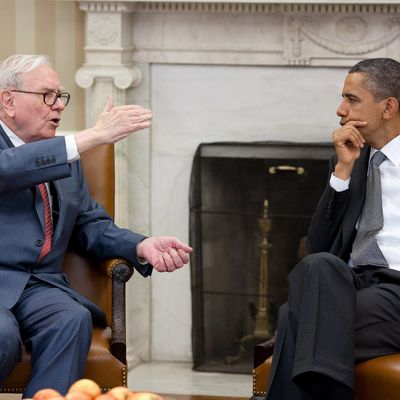
When you ask Democrats why they’re so fired up to pass the “Buffett Rule,” which ensures that super-rich people don’t pay a lower tax rate than the middle class, they don’t have very convincing answers. “Making sure that everyone plays by the same set of rules is key to ensuring the economic security of the middle class,” says White House spokesperson Amy Brundage. Well, no, it really isn’t the key. It’s not even in the top ten. Enacting the Buffett Rule would have a very, very marginal impact on a middle-class person’s life.
The amount of revenue raised by the Buffett rule is small — $47 billion over a decade if you assume the Bush tax cuts for the rich expire, three times that amount if you assume they won’t. If you think that’s a reason to vote against it, you also oppose canceling any wasteful spending program that costs less than that amount. It does, however, raise the question of why we’re doing this.
The central unfairness identified by the Buffett Rule is the lower rate for capital gains. The capital gains tax break is what lets Warren Buffett pay a lower tax rate than his secretary. It’s also the source of a lot of the distortions in the tax code, which are based on finding clever ways to convert ordinary income into capital gains income. The Wall Street Journal editorial page suspects the Buffett Rule is a sneaky plot to clear the way to end the capital gains preference. If only! The capital gains break is way too popular for the Democrats to really take on. So we’re left with the Buffett Rule, a reform that gestures toward the underlying problem without solving it. (Ezra Klein explains how the Senate plan will make low-tax millionaires pay higher rates but still won’t close the gap.)
If the Buffett Rule isn’t about middle-class economic security, and it’s not even about eliminating the ability of millionaires to pay less than their secretaries, what is it about? It’s about politics. But that doesn’t make it wrong or even cynical.
The central dividing line in American politics is the Republican Party’s refusal to accept any higher tax revenues on the rich. Republican taxophobia killed several attempts to reach an agreement over the budget deficit. Republicans are trying to hide this, because protecting the rich from tax hikes is not a popular position. The tax cuts in the House Republican budget are vague, and the budget’s author, Paul Ryan, hints that he really favors some kind of tax reform that would make the rich pay higher taxes. That’s not true — Ryan favors preserving or expanding the capital gains break, which would make it impossible for the rates he envisions to do anything but provide the rich with a tax cut, on top of the Bush tax cuts he proposes to lock in.
A senior administration official said today that breaking the GOP’s dogmatic insistence on preserving or deepening Bush-era tax rates for the rich is a key step to making a sensible budget reform possible. The Buffett Rule is a symbolic fight to expose Republican extremism. Yes, it’s a relatively small change. No, it won’t eliminate the deficit all by itself. But Republicans oppose it because they won’t accede to any higher taxes on the rich, no matter what — not even on people who are paying lower rates than the middle class.
If Republicans are going to defend an unpopular position, Democrats will make them defend it to its most absurd lengths.






























